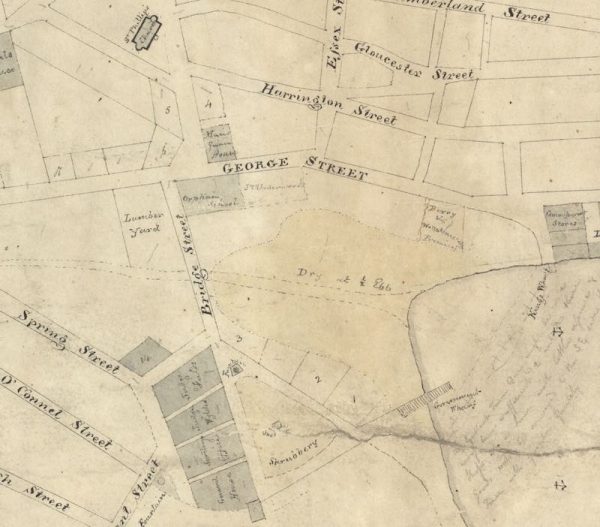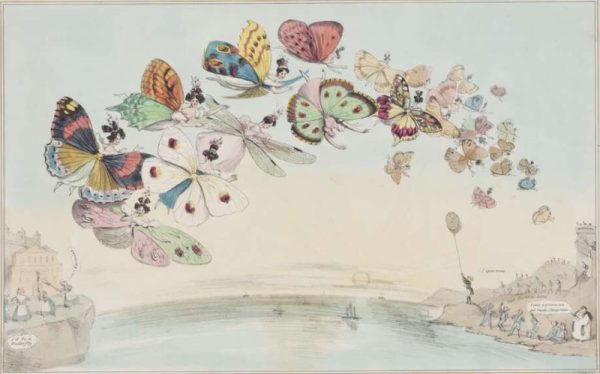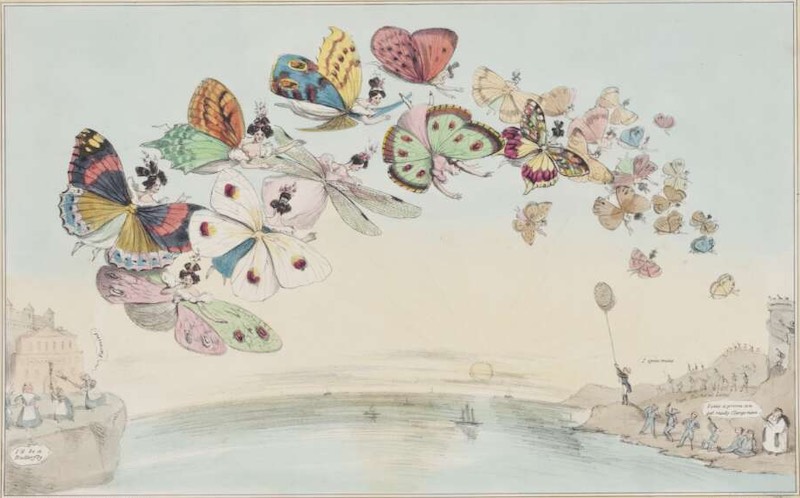Written by Patrick Bourke, RAHS Member
On 10 August 1832 the Red Rover arrived in Sydney Harbour with 202 free young unmarried Irish women onboard. This ship had left Cork, Ireland, on 10 April 1832. On 15 August the young women left the Red Rover and were housed in the Sydney lumber yard, which was at the southern corner of George and Bridge streets, until they could find employment. There is now a Royal Australian Historical Society green plaque on the wall of the entrance alcove of Moran House, 13-15 Bridge Street, to mark the site of the old Sydney lumber yard.[1] The arrival of the Red Rover young Irish women at the Sydney lumber yard was described in the Sydney Monitor on 15 August 1832. In the newspaper report, which was quite positive about the young women, it was noted that Governor Bourke and Miss Bourke ‘have paid a kind visit to these free women.’[2] The women on the Red Rover have sometimes been referred to incorrectly as convicts, as was pointed out by C.T. Burfitt in 1909.[3]

DETAIL OF ‘SKETCH OF THE TOWN OF SYDNEY’ 1821 SHOWING THE LUMBER YARD [STATE LIBRARY OF NSW]
From the records we have, it can be concluded that most of the young women were able to obtain employment soon after their arrival. Some did return to the Sydney lumber yard due to problems with their employment, while others were sent to the country areas. By the beginning of January 1833 only one young woman remained in the Sydney lumber yard.[5]
Tracing what happened to these young women and assessing their contributions to Australia as good servants and valuable wives is not an easy task but Elizabeth Rushen and Perry McIntyre in their book, Fair Game: Australia’s first immigrant women, have made a well-researched and balanced assessment of these young women which has also included the 200 free young unmarried women from London who arrived in Hobart on the Royal Princess on 23 August 1832. Whilst several of the Red Rover women fell on hard times and committed crimes, many others fell under the radar, with their lives only being discovered through their descendants doing family history research. Some of them lived to a good age and had large families.
After the arrival of the Red Rover in Sydney on 10 August 1832, and the arrival of the Princess Royal in Hobart on 23 August 1832, another fourteen ships would bring approximately 2,700 more free unmarried young women from England and Ireland to Australia between August 1833 and February 1837 as part of a migration scheme to correct the serious imbalance between the male and female population in the colonies. The young women who came to Australia on these sixteen ships during the 1830s were depicted as butterflies by the artist Alfred Ducote in his picture E-migration, or, A flight of fair game (1832).[6]

ALFRED DUCOTE, E-MIGRATION, OR, A FLIGHT OF FAIR GAME, LITHOGRAPH, 1832 [NATIONAL LIBRARY OF AUSTRALIA]
The Australian television series, Who Do You Think You Are? which has aired on SBS TV since 2008, has also uncovered the lives of two young women who came to Australia on two of these sixteen migrant ships during the 1830s. The actor Lex Marinos’ ancestor, Marianne Mortimer, arrived in Hobart on the Princess Royal on 23 August 1832, and the actress Kat Stewart’s ancestor, Eliza Martin, arrived in Hobart on the William Metcalfe on 24 January 1837.[8]
References:
[1] ‘Government Lumber Yard’, Dictionary of Sydney, <https://dictionaryofsydney.org/place/government_lumber_yard>, accessed 30 June 2022.
[2] Sydney Monitor, 15 August 1832, p.2, <https://trove.nla.gov.au/newspaper/article/32141886>
[3] C.T. Burfitt (Hon. Sec., Australian Historical Society), Letter to the Editor, Sydney Morning Herald, 14 August 1909, p.5, <http://nla.gov.au/nla.news-article15103181>
[4] Elizabeth Rushen & Perry McIntyre, Fair Game: Australia’s first immigrant women (Spit Junction: Anchor Books, 2010), p.72.
[5] Rushen & McIntyre, Fair Game, p.76.
[6] Alfred Ducote, E-migration, or, A flight of fair game, lithograph, 1832, <https://catalogue.nla.gov.au/Record/2662521>
[7] NSW State Archives, Women on the Red Rover and other early migrant ships (NRS5312, Reel 2795, [4/4822]).
[8] Who Do You Think You Are? Series 5. Aired on SBS TV on 30 April 2013; Who Do You Think You Are? Series 11. Aired on SBS TV on 23 June 2020.
Published online: 10 August 2022


Thank you for this detailed information, my 2nd great aunt was one of the 202 free women who bravely travelled on the Red Rover. she was Ellen Joyce. Very brave young ladies!! I wonder if any photos of the ship and passengers exists?
Greetings Kate. The Art Gallery of NSW records the first photograph in NSW as taken in Sydney’s Bridge Street in 1841. Sadly, too late for our fair game.
source: https://www.artgallery.nsw.gov.au/artsets/51b88k
My wife Gail’s ancestor came to Australia under a scheme similar to the Bounty Scheme referred to above, known as the Famine Orphan Scheme. The women, aged 14 to 20, had been orphaned by the famine and were recruited from workhouses across the 32 counties of Ireland. The scheme was devised by Earl Grey, Secretary of State for the Colonies.
Her name was Julia Brien, a 16 yo from the Kilkenny Workhouse. Her story can be found here: https://heppellsinoz.weebly.com/julia-brien–irish-famine-orphan.html
Rosanna Sheehan came on the Red Rover. She married John Green in 1835. She died in 1893 and is buried in the Forbes Cemetery in NSW.
Hello Rhonda
My great, great grandmother, Mary Downey lived at Millburn Creek, near Cowra. She lived to 1896 and is buried in the Frogmore Catholic Cemetery. Frogmore between Boorowa and Cowra , was a copper mining settlement during the 19th century. Mary had nine children. One her sons, Michael Bourke, was killed in a copper mining collapse in 1884. Michael and Mary’s second husband, Phillip Saywaker, are also buried in the Frogmore Catholic Cemetery.